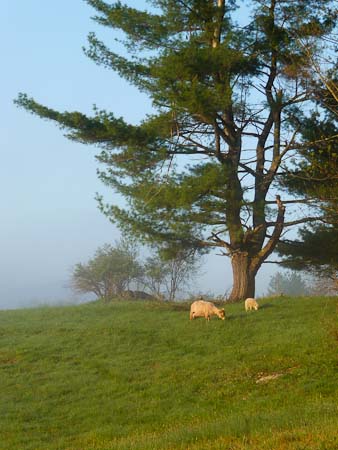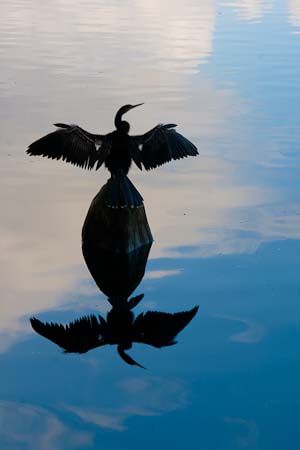 After having had the pleasure of being in the presence of a number of “masters” in the last couple of weeks, I’m deeply immersed in this inquiry. What is authentic presence really?
After having had the pleasure of being in the presence of a number of “masters” in the last couple of weeks, I’m deeply immersed in this inquiry. What is authentic presence really?
Here are some examples of presence that I’ve experience:
- I attended a facilitated gathering of folks recently where the lead person demonstrated a remarkable ability to simply be himself whether he was talking to me one-on-one or talking to the entire group. There appeared to be no separation between his public self and his private interactions and all his interactions seemed casual, easy going, and relaxed while at the same time right-on and very direct.
- Later that week I attended a concert performed by two young singer/song-writers/musicians. The woman of the pair, especially, was mesmerizing whether she was singing, talking to the audience, or “off-line” dealing with issues of managing the sound system. As my friends and I tried to identify what it was that made her so intriguing we agreed that, once again, she was just herself, perfectly comfortable in her own skin, and not trying to put on a good “performance”. She was, though, completely engaged with her songs, her connection with the audience, and what was happening in the moment.
- Just this week I have begun an amazing two week movement immersion opportunity with a professional dance company, Pilobolus, where we are spending a lot of time focusing on this quality I call “embodied presence” when dancers are on stage. What I’ve learned so far is that everything, from the slightest movement of the eyes to the twitch of a little finger, will communicate something to the audience. Dancers on stage need to be deliberate, specific, and conscious of themselves or the quality of real presence is shattered. Even a casual, relaxed smile can be a distraction.
- In several exercises we did as part of the improvisational dance experience in this workshop, I became very aware of letting go entirely of my sense of self as the group of us dancer responded without thought and moved as a collective, a single unit, much like a flock of birds or school of fish. I became aware of a non-personal sense of presence that was held within the group as a whole rather than each of us as individuals. Yesterday, there was a moment when three of us were moving together in a frenzy in the center of the room to some rather chaotic music, when suddenly, with absolutely no forethought or signal all three of us froze in space. In that very same instant, without any warning whatsoever that I was aware of, the music changed, becoming softer. For the second time in two weeks, in two very different contexts, I heard someone use the word “us-ness” to describe this kind collective presence.
 Last night I went to a party which ended with an open mic. In a very casual way, musicians of all sorts stood up and sang and played well known songs or songs of their own composition. There were many very talented people in the crowd. One young nine year old girl stood out for me with her presence. She came to the mic with her guitar in hand preparing to sing and play her own lovely composition. Her feet were planted wide. She stood tall and confidently. Her smile was brilliant. Her energy, passion and enthusiasm was clear in every cell of her body.
Last night I went to a party which ended with an open mic. In a very casual way, musicians of all sorts stood up and sang and played well known songs or songs of their own composition. There were many very talented people in the crowd. One young nine year old girl stood out for me with her presence. She came to the mic with her guitar in hand preparing to sing and play her own lovely composition. Her feet were planted wide. She stood tall and confidently. Her smile was brilliant. Her energy, passion and enthusiasm was clear in every cell of her body.
So, what is authentic presence really? Each of these examples touches on some aspect.
While acknowledging that there is a clear distinction between speaking and performing dance or music, on the surface, these examples reflect two, seemingly contradictory, experiences of presence. Should we relax and simply be ourselves ? Or, should we pay exquisite attention to every detail, and recognize that we can shatter that sense of presence if we step out of that state of deliberate attention to the moment? Is it possible to do both at the same time?
And that leads me to the question, are these really different experiences? Partly, I think my confusion about these different aspects of presence reflects the difference between self-conscious and consciousness-of-self.
The first two examples are of speakers/performers who were not at all self-conscious. When we are self-conscious, our focus is entirely on how we look to the outside world. This, in turn, often results in our being something other than who we truly are as we try to become the persona we perceive others want us to be. When we let go of the need to “look good” we can relax into ourselves, be present in the moment, and be much more authentically available to the people around us. This was certainly true of my first two examples.
The examples I cited, on the presence of dancers, highlight the importance of being conscious-of-self and completely embodied. When we are conscious-of-self we have access to all of who we are (what we think, how we feel, and how we move) and are able to choose how to respond from moment to moment. Ironically, with true embodied presence, the primary focus of an “authentic” dancer is not to look good to the outside world (although, clearly, an important part of choreography is to communicate something visually to the audience), but rather to be fully aware moment to moment and to do so with a full commitment to each movement as it’s expressed.
As I think about it now that I’m writing about it, I don’t believe that being un-self-conscious and being conscious-of-self are mutually exclusive. Instead, I think that we can be relaxed and comfortable with ourselves in truly authentic way when we are communicating with the audience as we engage a deliberate focus, conscious intention and embodied sense of self.
Another way to possibly reconcile these two seemingly contradictory aspects of presence has to do with our intention and the circumstances under which we are communicating. If the group is small and intimate, then speaking casually and conversationally rather than performing makes a lot of sense. If, though, we are presenting to a large group of people, we might need to be more precise with our presence and in some way become bigger than who we are in ordinary, day-to-day life. I know that there’s a way when I speak to a large group I find myself stepping into a bigger, more defined, sense of myself.
But then… I remember going to see the Dalai Lama at the then Fleet Center in Boston several years ago. There were 20,000 people in the audience… 20,000!!! What struck me most about the Dalai Lama’s presence was how completely natural and authentic he was. Imagine just being yourself in front of 20,000 people!

Interesting observation, John. I’m very intrigued by the power of the collective presence and your example is a good one.
Carla:
Great article.
Your discussion of a non-personal sense of presence is very much what I experienced in the Army, many moons ago. We all came there from somewhere else, with distinct backgrounds and identities, and within days we were transformed into a single unit with a single mission. We were all very aware of how important this collective presence was to our successful performance.
Best, John
Presence is sometimes the pause between phrases, sentences, movements — the self-controlled nothing that allows the something to be seen. The focus may be outward or inward. Other times it may be the soft voice, not trying to be heard over the noise, that draws the attention of listeners. Marlon Brando was a master of both of these forms of presence. Entertainers (I’m thinking of Taj Mahal) have a different kind of presence, in which they actively manipulate the audience, telling it what to do, or teasing out the reaction they want. Presence is centeredness, the complete lack of self-consciousness. People with presence own the space they are in.
Thanks Carla for beginning this inquiry and offering examples from your life this summer. One experience from my summer is going to a Joan Armatrading concert. Joan identifies herself more as a songwriter than as a performer, so when she was on stage with not much more than than her willingness to share her vulnerable gift of song, I felt touched by a brilliant being. Every note, every gesture, the expression in her eyes (we were in row three), the pure sweetness of her essence radiated.
The moment that touched me the most was at the end of singing “Willow,” one of her most famous songs. She gradually sang softer and softer, then motioned to the audience to sing along, and together our voices, hearts, souls connected. We knew the words, we sang together, we became one. She stopped singing and we continued. She led us/let us sing her words. She stood there full of emotion, her heart touched listening to her fans. She was authentic presence.